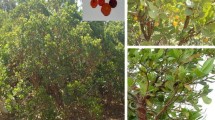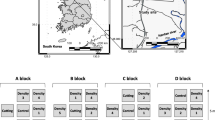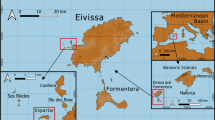Abstract
The main objective of this study was to analyze if Acacia farnesiana, an introduced shrub from North and Central American tropics is spreading from areas in which it was introduced, and also to determine which animals operate as vectors for the shrub dispersion in the study area. The study site was located in southern Gran Canaria, one of the islands of the Canary Island archipelago. We selected six ravines in an area where approximately 40 plants of A. farnesiana were planted around 40 years ago. We analyzed the size structure of the population of A. farnesiana (density and biovolume) in the ravines, as well as its spatial distribution, in order to assess the degree of aggressiveness of this shrub in terms of spreading and expansion. Our results suggest that this shrub is spreading to new areas very quickly due to dispersion of seed by rabbits and an enhanced germination by the action of Mimoseste mimosae, a bruchid that decreases the germination period of the seed once it has separated from the fruit. Based on the results obtained in this study, we strongly suggest that managers of this area consider a management program to control further spread.



Similar content being viewed by others
References
Arévalo JR, Fernández-Palacios JM (2005) Gradient analysis of exotic Pinus radiata plantations and potential restoration of natural vegetation in Tenerife, Canary Islands (Spain). Acta Oecologica 27:1–8
Arévalo JR, Naranjo A, Salas M (2005) Regeneration in a mixed stand of native Pinus canariensis and introduce Pinus pinea species. Acta Oecologica 28:87–94
Batista JLF, Maguire DA (1998) Modeling the spatial structure of tropical forests. For Ecol Manag 110:293–314
Busing RT (1996) Estimation of tree replacement in an Appalachian Picea-Abies forest. J Veg Sci 7:685–694
Carlquist S (1974) Island biology. Columbia University Press, Columbia
Carmona R, Carvalho BS, Carlvalho R (2001) Controle de Acacia farnesiana e de Mimosa pteridofita em pastagem. Pesq Agrope Bras 36:1301–1307
Collins SL, Klahr SC (1991) Tree dispersion in oak-dominated forest along an environmental gradient. Oecologia 86:471–477
Condit R, Hubbell SP, Foster RB (1992) Recruitment near conspecific adults and the maintenance of tree and shrub diversity in a neotropical forest. Am Nat 140:261–286
D’Antonio CM, Kark S (2002) Impacts and extent of biotic invasions in terrestrial ecosystems. Trends Ecol Evol 17:202–204
Diggle PJ (1983) The statistical analysis of spatial point patterns. Academic Press, New York
Duncan RD (1991) Competition and the coexistence of species in a mixed podocarp stand. J Ecol 79:1073–1084
Eviner VT (2004) Plant traits that influence ecosystem processes vary independently among species. Ecology 85:2215–2229
Eviner VT, Chapin FSIII (2003) Biogeochemical interactions and biodiversity. In: Melillo JM, Field CB, Moldan M (eds) Element interactions: rapid assessment project of SCOPE. Island Press, Washington, pp 151–173
Fernández-Palacios JM, de los Santos A (1996) Ecología de las Islas Canarias. Muestreo y análisis de poblaciones y comunidades. Sociedad La Cosmológica, Santa Cruz de Tenerife
Fuentes ER, Avilés R, Segura A (1989) Landscape change under indirect effects of human use: the Savanna of Central Chile. Landsc Ecol 2:73–80
Grotkopp E, Rejmánek M, Sanderson MJ, Rost TL (2004) Evolution of genome size in pines (Pinus) and its life-history correlates: super-tree analyses. Evol Int J Org Evol 58:1705–1729
Haase P, Pugnaire FI, Clark SC, Incoll LD (1997) Spatial pattern in Anthyllis cytisoides shrubland on abandoned land in southeastern Spain. J Veg Sci 8:627–634
Hatton TJ (1989) Spatial patterning of sweet briar (Rosa rubignosa) by vertebrate species. Aust J Ecol 14:199–205
He F, Legendre P, LaFrankie JV (1997) Distribution patterns of tree species in a Malaysian tropical rain forest. J Veg Sci 8:105–114
Holmgren M (2002) Exotic herbivores as drivers of plant invasions and switch to ecosystem alternative states. Biol Invasions 4:25–33
Horn HS (1975) Markovian processes of forest succession. In: Cody M, Diamond J (eds) Ecology and evolution of communities. Belknap Press, Cambridge, Massachusetts, pp 196–211
ITGE (1990) Mapa geológico de Gran Canaria E. 1:100.000. ITGE, Madrid
Izquierdo I, Martín JL, Zurita N, Arechavaleta M (2004) Lista de especies silvestres de Canarias (hongos, plantas y animales terrestres). Consejería de Política Territorial y Medio Ambiente Gobierno de Canarias
Kunkel G (1976) Gran Canaria, Tenerife y La Gomera: notas florísticas y adiciones. Cuad Bot Canar 26(27):75–81
Lockwood JK, Simberloff D, McKinney MK, von Holle B (2001) How many and which, plants will invade natural areas? Biol Invasions 3:1–8
Mack RN, Simberloff D, Lonsdale WM, Evans H, Clout M, Bazzaz FA (2000) Biotic invasions: causes, epidemiology, global consequences, and control. Ecol Appl 10:689–710
Miller MF (1996) Acacia seed predation by bruchids in an African savanna ecosystem. J Appl Ecol 33:1137–1144
Moeur M (1993) Characterizing spatial patterns of trees using stem-mapped data. For Sci 39:756–775
Parrotta JA (1992) Acacia farnesiana (L.) Willd. Aroma, huisache. SO-ITF-SM-49. U.S. Department of Agriculture, Forest Service, Southern Forest Experiment Station, New Orleans, LA
Pérez PL, García A, Heene A (1999) Control y erradicación del “rabo gato” (Pennisetum setaceum). Excmo. Cabildo de La Palma. S/C de La Palma
Pimentel D (2002) Biological invasions: economic and environmental costs of alien plant, animal, and microbe species. CRC Press, Boca Raton
Rejmanek M, Richardson DM (1996) What attributes make some plant species more invasive? Ecology 77:1655–1661
Rejmanek M, Richardson DM, Higgins SI, Pitcairn MJ, Groktopp E (2005) Ecology of the invasive plants. State of the art. In: Mooney HA, Mack RN, McNeely JA, Neville LE, Schei PJ, Waage JK (eds) Invasion alien species: a new synthesis. Scope 63. Island Press, Washington, pp 104–161
Richardson DM, Higgins SI (1998) Pines as invaders in the southern hemisphere. In: Richardson DM (ed) Ecology and biogeography of Pinus. Cambridge University Press, Cambridge, pp 450–473
Richardson DM, Allsopp N, D’Antonio CM, Milton SJ, Rejmanek M (2000) Plant invasions—the role of mutualisms. Biol Rev 75:65–93
Sánchez J, Ríos C, Pérez-Chacón E, Suárez C (1995) Cartografía Potencial del Medio Natural de Gran Canaria. Cabildo Insular de Gran Canaria, Universidad de Valencia, Universidad de Las Palmas de Gran Canaria
Sanders NJ, Weltzin JF, Crutsinger GM, Fitzpatrick MC, Nuñez MA, Oswalt CM, Lane KE (2007) Insects mediate the effects of propagule supply and resource availability on a plant invasion. Ecology 88:2383–2391
Sanz-Elorza M, Dana ED, Sobrino E (2005) Aproximación al listado de plantas vasculares alóctonas invasoras reales y potenciales en las islas Canarias. Lazaroa 26:55–66
Shackleton CM, Shackleton SE, Buiten E, Bird N (2007) The importance of dry woodlands and forests in rural livelihoods and poverty alleviation in South Africa. For Policy Econ 9:558–577
Silva L, Smith CW (2004) A characterization of the non-indigenous flora of the Azores Archipelago. Biol Invasions 6:193–204
SPSS (1986) SPSS/PC + V.6.0. Base manual. SPSS Inc., Chicago, IL
Stock WD, Wienand KT, Baker AC (1995) Impacts of invading N2 fixing Acacia species on patterns of nutrient cycling in two Cape ecosystems: evidence from soil incubation studies and 15N natural abundance values. Oecologia 101:375–382
Strasberg D (1995) Processus d’invasion par les plantes introduites à la Réunion et dynamique de la végétation sur les coulées volcaniques. Ecologie 26:169–180
Suárez V (1987) La propiedad pública, vinculada y eclesiástica en Gran Canaria, en la crisis del Antiguo Régimen. Cabildo Insular de Gran Canaria, Las Palmas de Gran Canaria
Súarez F (1997) Mogán. De pueblo aislado a cosmopolita. Ilustre Ayuntamiento de Mogán, Madrid
Szwagrzyk J (1990) Regeneration of forest related to the spatial structure of trees: a study of two forest communities in Western Carpathians, southern Poland. Vegetatio 89:11–22
Tassin J, Revière JN, Cazanove M, Bruzzese E (2006) Ranking of invasive woody plant species for management on Réunion Island. Weed Res 46:388–403
Traveset A (1991) Pre-dispersal seed predation in Central American Acacia farnesiana: factors affecting the abundance of co-ocurring bruchid beetles. Oecologia 87:570–576
Vacek S, Lepš J (1996) Spatial dynamics of forest decline: the role of neighboring trees. J Veg Sci 7:789–798
Walters C (1986) Adaptive management of removable resources. Macmillan, New York
Weigand T (2004) Introduction to point pattern analysis with Ripley’s L and O-ring statistic using the Programita Software. Department of Ecological Modelling, UFZ—Centre of Environmental Research, Leipzig
Woods KD (1979) Reciprocal replacement and the maintenance of codominance in a beech-maple forest. Oikos 33:31–39
Yelenik SG, Stock WD, Richardson DM (2007) Functional group identity does not predict invader impacts: differential effects of nitrogen fixing exotic plants on ecosystem function. Biol Invasions 9:117–125
Zar JH (1984) Biostatistical analysis, 2nd edn. Prentice-Hall, Englewood Cliffs, NJ
Acknowledgments
This work is the part of the study program of exotic species carried out by the Invasive Species: Interinsular Research Group (EIGI) of the University of La Laguna and University of Las Palmas de Gran Canaria. We thank the “Consejería de Educación, Cultura y Deportes, Gobierno de Canarias” (Regional Government Department of Education, Culture and Sports) for providing funding for this project (Code: PI042004/096). We thank the students of Geography of University of Las Palmas de Gran Canaria, Lea de Nascimento, Elízabeth Fernández and Tamar de la Concepción from the University of La Laguna for their assistance in the sampling. We are also grateful for the collaboration of the fine staff of the Cabildo de Gran Canaria (especially Mr. Carlos Velázquez), who offered the use of their facilities in the Park and the Managers of the Society “Costa Canaria Venegueras” for access to the study site and collaboration with the members of this project. We thank Dr. Jerry Husak at Virginia Tech for his valuable comments on the manuscript and Heather Adams of ULPGC for translating it into English.
Author information
Authors and Affiliations
Corresponding author
Additional information
Nomenclature: Izquierdo et al. 2004.
Rights and permissions
About this article
Cite this article
Arévalo, J.R., Afonso, L., Naranjo, A. et al. Invasion of the Gran Canaria ravines ecosystems (Canary Islands) by the exotic species Acacia farnesiana . Plant Ecol 206, 185–193 (2010). https://doi.org/10.1007/s11258-009-9633-0
Received:
Accepted:
Published:
Issue Date:
DOI: https://doi.org/10.1007/s11258-009-9633-0




